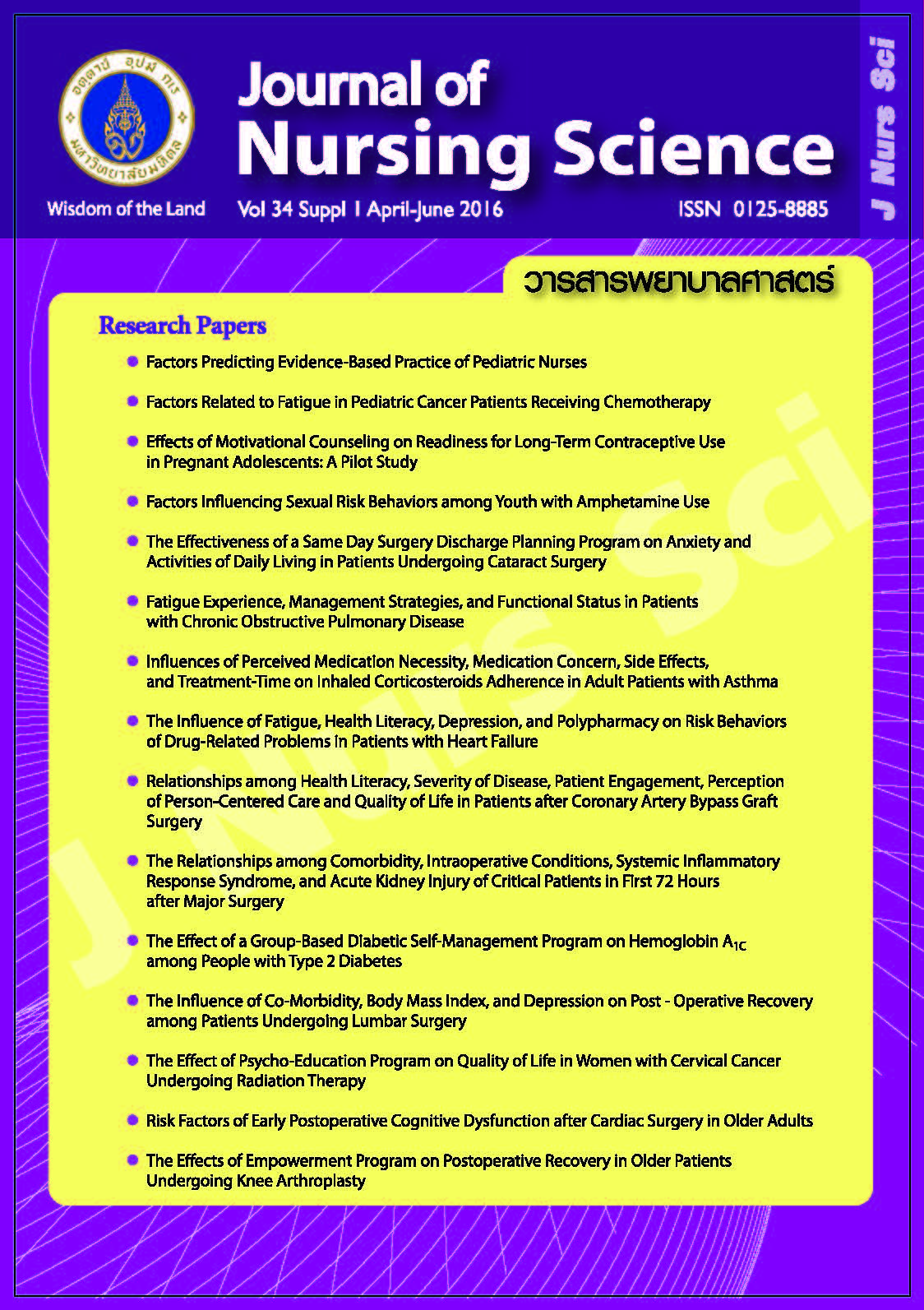Relationships among Health Literacy, Severity of Disease, Patient Engagement, Perception of Person-Centered Care and Quality of Life in Patients after Coronary Artery Bypass Graft Surgery
Main Article Content
Abstract
Abstract
Purpose: The objective of this study was to examine the relationships among health literacy, severity of disease, patient engagement, perception of person-centered care, and quality of life in patients after coronary artery bypass graft surgery (CABG).
Design: A descriptive correlation design.
Methods: The sample consisted of 94 patients who attended a heart surgery clinic for a second follow-up appointment after CABG at the Central Chest Institute. Data were collected by interviewing through a set of questionnaires consisting of socio-demographic data and clinical profile, Health Literacy Questionnaire, Patient Activation Measure, Consultation Care Measure and Medical Outcome Survey Short-Form 36. Data were analyzed by descriptive statistics and Pearson’s Product Moment Correlation Coefficient.
Main findings: The findings indicated that quality of life was good (M = 75.36, SD = 12.48), severity of disease from Cardiac Power Index average was at 0.58 Watts/m2, health literacy, patient engagement and perception of person-centered care were at a high level (M = 7.87, 70.17, 5.32 respectively). Health literacy and perception of person-centered care were statistically related to quality of life among patients after 10-20 weeks of post CABG. (r = .214; r = .226, p < .05, respectively).
Conclusion and recommendations: Nurses should promote health literacy of patients by developing a system to disseminate knowledge and advice on self-care practices before hospital discharge, together with the development of quality of the service system by utilizing person-centered
care to patients after coronary artery bypass graft surgery based on the patients’ perceptions.
ความสัมพันธ์ระหว่างความแตกฉานทางสุขภาพ ความรุนแรงของโรคความรับผิดชอบของผู้ป่วย และการรับรู้การดูแลแบบบุคคลเป็นศูนย์กลางกับคุณภาพชีวิตของผู้ป่วยภายหลังผ่าตัดทำทางเบี่ยงหลอดเลือดหัวใจ
บทคัดย่อ
วัตถุประสงค์: เพื่อศึกษาความสัมพันธ์ระหว่างความแตกฉานทางสุขภาพ ความรุนแรงของโรค ความรับผิดชอบของผู้ป่วย และการรับรู้การดูแลแบบบุคคลเป็นศูนย์กลาง กับคุณภาพชีวิตของผู้ป่วยภายหลังผ่าตัดทำทางเบี่ยงหลอดเลือดหัวใจ
รูปแบบการวิจัย: การวิจัยเชิงสหสัมพันธ์
วิธีดำเนินงานวิจัย: กลุ่มตัวอย่างเป็นผู็ป่วยที่มาติดตามรักษาครั้งที่ 2 ภายหลังผ่าตัดทำทางเบี่ยงหลอดเลือดหัวใจ จำนวน 94 ราย ที่คลินิกศัลยกรรมโรคหัวใจ สถาบันโรคทรวงอก เก็บรวบรวมข้อมูลด้วยการสัมภาษณ์โดยใช้แบบบันทึกข้อมูลส่วนบุคคล แบบสอบถามความแตกฉานทางสุขภาพ แบบสอบถามความรับผิดชอบของผู้ป่วย แบบสอบถามการรับรู้การดูแลแบบบุคคลเป็นศูนย์กลาง และแบบสอบถามคุณภาพชีวิต วิเคราะห์ข้อมูลโดยใช้ค่าสัมประสิทธิ์สหสัมพันธ์ของเพียร์สัน
ผลการวิจัย: กลุ่มตัวอย่างมีคุณภาพชีวิตอยู่ในระดับดี (M = 75.36, SD = 12.48) ความรุนแรงของโรคตามค่า Cardiac Power Index เฉลี่ย 0.58 Watts/m2 ความแตกฉานทางสุขภาพ ความรับผิดชอบของผู้ป่วย และการรับรู้การดูแลแบบบุคคลเป็นศูนย์กลางอยู่ในระดับสูง (M = 7.87, 70.17, 5.32 ตามลำดับ) ความแตกฉานทางสุขภาพและการรับรู้การดูแลแบบบุคคลเป็นศููนย์กลางมีความสัมพันธ์ทางบวกกับคุณภาพชีวิตของผู้ป่วยภายหลังผ่าตัดทำทางเบี่ยงหลอดเลือดหัวใจในช่วง 10-20 สัปดาห์ อย่างมีนัยสำคัญทางสถิติ (r = .214; r = .226, p < .05)
สรุปและข้อเสนอแนะ: พยาบาลควรส่งเสริมความแตกฉานทางสุขภาพของผู้ป่วยด้วยการพัฒนาระบบการให้ความรู้และคำแนะนำการปฏิบัติตนก่อนจำหน่ายร่วมกับพัฒนา คุณภาพระบบการบริการโดยนำรูปแบบการดูแลแบบบุคคลเป็นศูนย์กลางมาใช้ในการดูแลผู้ป่วยผ่าตัดทำทางเบี่ยงหลอดเลือดหัวใจ โดยประเมินผลการดูแลจากการรับรู้ของผู้ป่วย
คำสำคัญ: การผ่าตัดทำทางเบี่ยงหลอดเลือดหัวใจ คุณภาพชีวิต ความแตกฉานทางสุขภาพ การรับรู้การดูแลแบบบุคคลเป็นศูนย์กลาง
Article Details
Copyright Notice: Nursing Science Journal of Thailand has exclusive rights to publish and distribute the manuscript and all contents therein. Without the journal’s permission, the dissemination of the manuscript in another journal or online, and the reproduction of the manuscript for non-educational purpose are prohibited.

Disclaimer: The opinion expressed and figures provided in this journal, NSJT, are the sole responsibility of the authors. The editorial board bears no responsibility in this regard.


